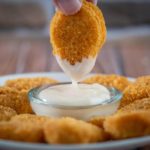McDonald’s, the world-renowned fast-food chain, has been serving its iconic burgers to millions of customers worldwide for decades. A characteristic that often sparks curiosity is the flatness of their burgers.

The thin, uniform patties are a signature trait of McDonald’s burgers, distinguishing them from those served by other fast-food outlets or homemade versions.
Let’s explore why McDonald’s burgers are so flat, exploring the factors contributing to this distinctive feature.
Unraveling the Mystery: Why are McDonald’s Burgers Flat?
Standardization and Uniformity
One of the critical reasons McDonald’s burgers are so flat is the company’s commitment to standardization and uniformity across all their products globally. McDonald’s strives to ensure that every customer receives the same outcome regardless of where they are.
This consistency in size and shape allows the company to maintain quality control and deliver the same taste experience to all customers.
The uniformity of their burger patties also simplifies the cooking process. With each cake being the same thickness, cooking times are consistent, ensuring each burger is perfectly cooked.
This level of standardization extends beyond the cooking process, simplifying other areas such as packaging and transportation, where uniform sizes allow for more efficient use of space and materials.
Fast Cooking Process
The fast-paced environment of fast-food restaurants requires quick cooking times, and the flatness of McDonald’s burgers plays a crucial role.
Thinner patties cook faster than thicker ones, allowing McDonald’s to serve its customers quickly, especially during peak hours. Quick cooking also minimizes the risk of undercooked meat, ensuring food safety.
Rapid cooking also contributes to the flavor and texture of the burgers. The high heat applied to the thin patties creates a flavorful sear on the outside while keeping the inside tender.
This fast searing process locks in the juices, preserving the beef’s natural flavors and delivering the distinctive taste that McDonald’s burgers are known for.
Space Efficiency
In addition to cooking speed and uniformity, the flatness of McDonald’s burgers also contributes to space efficiency. Flatter burgers take up less space, allowing more patties to be cooked simultaneously on the grill.
This speeds up the cooking process and maximizes the use of the cooking surface area, leading to higher productivity. Space efficiency extends beyond the grill.
From storage in the freezer to placement in the packaging, the thin, flat shape of the patties allows for more efficient use of space. This is particularly important in a fast-food restaurant where space is often limited and needs to be utilized effectively.
Cost Efficiency
Cost efficiency is another crucial factor. Flatter patties require less meat, which helps reduce costs. This cost efficiency enables McDonald’s to price their burgers more affordably, making them accessible to a broader range of customers.
Using less meat per patty allows McDonald’s to serve more burgers with the same amount of meat.
This reduces the cost per burger and allows for higher profit margins. In the competitive fast-food industry, where pricing can significantly influence customer choices, this cost efficiency provides McDonald’s with a crucial advantage.
Additional Factors Contributing to the Flatness of McDonald’s Burgers
Tradition and Brand Identity
Over the years, the flatness of McDonald’s burgers has become a part of the brand’s identity. The unique shape of the burgers is easily recognizable and differentiates McDonald’s from other fast-food chains.
This tradition is not just a haphazard development but a carefully nurtured aspect of McDonald’s branding strategy.

The flat burger patty is an integral part of the McDonald’s experience. It’s a visual cue that immediately signifies “McDonald’s,” much like the Golden Arches or Ronald McDonald himself.
This flatness and uniformity give customers a sense of familiarity and comfort. It’s a reassurance of consistency, a promise that no matter where you are, a McDonald’s burger will consistently deliver the same taste and texture you know and love.
Moreover, this flat design has been propagated in the brand’s marketing and advertising materials, further strengthening its association with its identity.
It’s part of what customers expect when they order a burger from McDonald’s, and changing it could disrupt the familiarity that customers associate with the brand.
Taste and Texture
While it might seem like a minor detail, the thickness of a burger patty can significantly impact its taste and texture, and McDonald’s thin, flat cakes have been designed with this in mind.
A flat patty provides a good balance of meat, toppings, and bun in each bite. It ensures that the burger is not overly meaty, which might overshadow the flavors of the other ingredients.
The thin patties also allow for an even heat distribution during cooking, ensuring the cake is cooked evenly throughout. This results in a consistent texture across the entire patty, with no undercooked or overcooked sections.
The high surface-to-volume ratio of the flat patties also means that more of the meat comes into contact with the grill, creating a larger seared surface area. This searing enhances the patty’s flavor, contributing to the unique taste of McDonald’s burgers.
Furthermore, the thinness of the patties allows for an even distribution of flavors. Each bite of a McDonald’s burger includes a bit of everything – the meat, the cheese, the sauce, and the various toppings.
This balance contributes to the overall taste experience that McDonald’s aims to deliver.
Ease of Eating
Lastly, one of the most practical reasons behind the flatness of McDonald’s burgers is the ease of eating.

They are less likely to fall apart while eating, providing a more convenient and less messy dining experience, particularly for customers who enjoy their meals while driving or walking.
The flatness of the burgers also makes them easier to handle, particularly for children. The thin profile of the burger fits comfortably in the hand, making it easier to hold and bite into.
This is an essential consideration given McDonald’s broad customer base, including small children and older adults.
Moreover, the flat design of the burgers ensures that they stack neatly within the bun, reducing the likelihood of toppings spilling out during eating. This makes the burgers easier to eat and contributes to a cleaner, more enjoyable dining experience.
Conclusion
The flatness of McDonald’s burgers might seem like a simple design choice, but as we’ve explored, there’s much more to it than meets the eye.
From ensuring consistency and quick service to maximizing cost and space efficiency, the flatness of McDonald’s burgers plays a crucial role in the brand’s global success.
Understanding these factors can provide valuable insight into the fast-food industry’s operational strategies and the importance of product design in enhancing customer experience.





